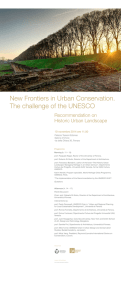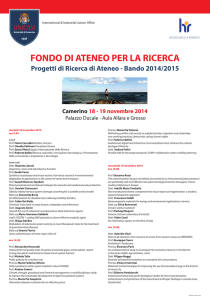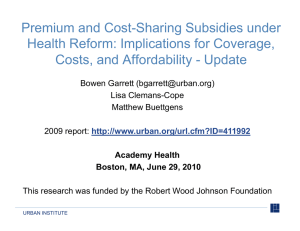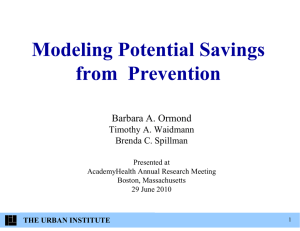Estimating the Effects of a Medicare Buy In Program Medicare Buy-In Program
advertisement
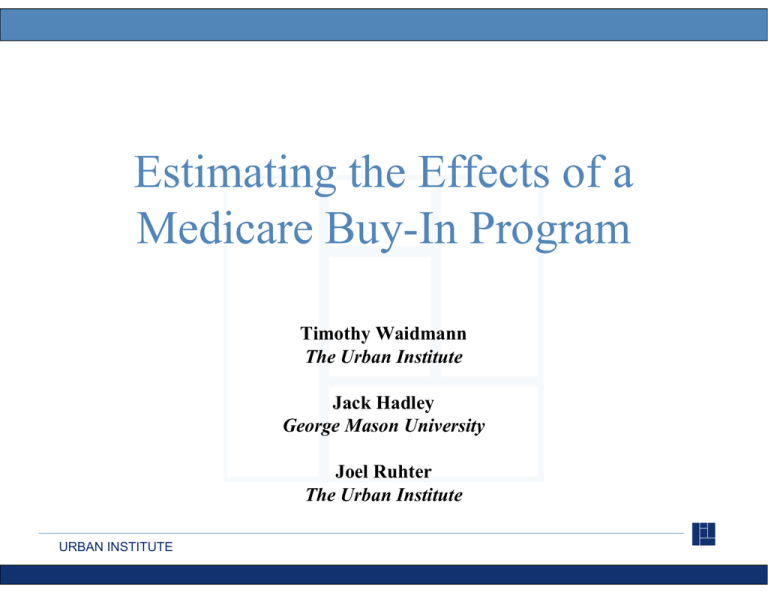
Estimating the Effects of a Medicare Buy-In Buy In Program Timothy Waidmann The Urban Institute Jack Hadley George Mason University Joel Ruhter The Urban Institute URBAN INSTITUTE Motivation • Insurance coverage prior to Medicare entitlement matters for health and health care spending (McWilliams et al 2007; Hadley & Waidmann, Waidmann 2006) • Pre-reform: 10 – 15% uninsured • Even E post-reform: t f IIncreases in i early l retirement, ti t decreases in employer sponsored retiree coverage, growing costs overall, still a high high-risk risk group • Buy-in as a limited public option? • Past work has not considered potential future Medicare savings from prior universal coverage. URBAN INSTITUTE One approach: Medicare Buy-in Buy in for the near-elderlyy • Several proposals, both as stand-alone programs and as part of reform debate debate. • Medicare’s advantages over private options – – – – Relatively low administrative costs Pooling risks broadly Market ppower in keeping p g costs down Could relieve risk pools in exchanges, where age rating is limited. • Advantage over new public program: Established program, including a buy-in mechanism URBAN INSTITUTE Our approach to modeling MBI • Data: MEPS-HC 2002-2004 – G Generate t actuarially t i ll fair, f i age-rated t d premium i schedule h d l for plan equivalent to average private plan (Parts A,B,D,Medigap) , , , g p) – Estimate private premiums for the privately insured • Currentlyy insured free to choose MBI – Develop choice rules to estimate who switches • Assume individual mandate,, pproviding g subsidies for low-income (though only in MBI) URBAN INSTITUTE Premium Models Medicare Buyin Private • Model: 3rd party spending=f(age,insurance) – Uninsured and privately i insured, d 19-64 19 64 & 0-18 0 18 • Predict spending for fully insured person by age • Add 5% load • Total over HIU • Subsidies up to 300%FPL (Less generous than PPACA) • Model: 3rd party spending=f(health, di f(h l h demographics, firm size) • Calculate schedule of predicted spending by HIU size, firm size from predicted values within cells • Add load by firm size (40% down to 8%) • Add variance URBAN INSTITUTE Choice Rules • Whole HIU moves together • Consider premium + OOP costs (also predicted) • Consider FULL private premium • Bigger cost differentials lead to more switching ( (=-2.0) 2.0) URBAN INSTITUTE Who chooses MBI over Private? 80% Age-based Flat 70% 60% 50% 40% 30% 20% 10% 0% 50 51 URBAN INSTITUTE 52 53 54 55 56 57 58 59 60 61 62 63 64 Composition of MBI Enrollment, Enrollment by income & p prior insurance status Uninsured, <300FPL (6.5 million) Insured, >300FPL (41.6 million) Insured, <300FPL (9.9 million) Uninsured, >300FPL (4 0 million) (4.0 URBAN INSTITUTE The effect on private insurance pool • Even though predicted enrollees are concentrated at the young end of eligible age g range, g , still more expensive p than average g in private pool • 7% red reduction ction in average a erage expenditures e pendit res among privately insured URBAN INSTITUTE Aggregate impacts • Counting changes in tax expenditures and revenue, subsidy b id costs, premium i revenue, net annual increase in government expenditure of $1620 bbn. (over ( pre-reform f bbaseline) li ) • On per-uninsured basis, $1,524 • Trade-off between current tax-subsidy of private g income)) and direct subisdyy of insurance ((higher premiums (lower income). • Underwriting loss in MBI URBAN INSTITUTE Alternate MBI parameters • Exclude employees of largest firms (>500) • Higher load under regulated private market (15% v 5%) • Reduced subsidies • Alternative assumption about switching behavior • All result in lower enrollment/cost and higher individual expenditure URBAN INSTITUTE Summary • A subsidized MBI option could cover a high-risk group off uninsured i d & also l attract lots l off privately i l insured without subsidy • Could improve private risk pool • Tax revenues could offset subsidy y ppayments y (redistributive) • Likely underwriting loss – could rebalance rebalance, but there is a tradeoff with subsidy payments URBAN INSTITUTE Policy Implications for a future public option • If affordable exchange plans do not emerge – Post-reform, a voucher system and subsidies would be important to attracting enrollees. – Potentially favorable effect on private risk pool, especially under PPACA age rating rules • These results assume no exertion of market power by public payer, likely an important source of savings. URBAN INSTITUTE
